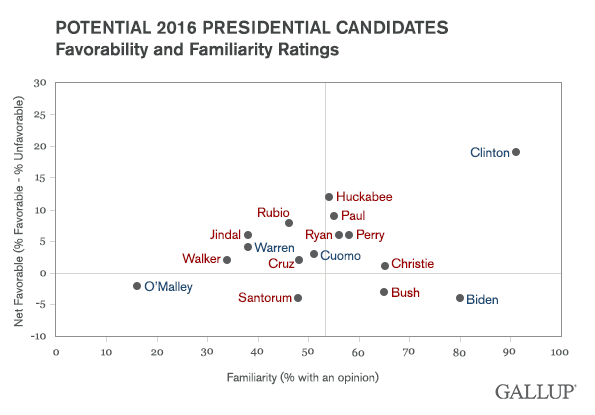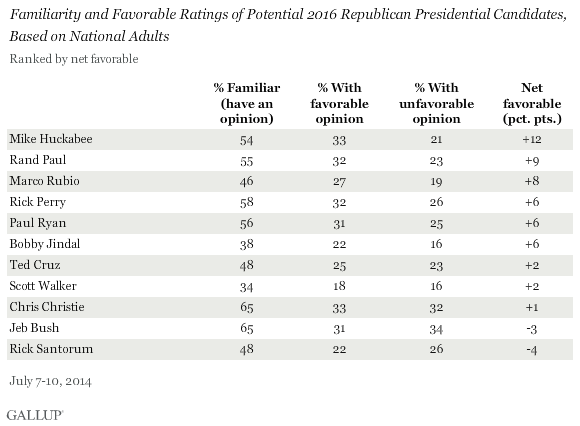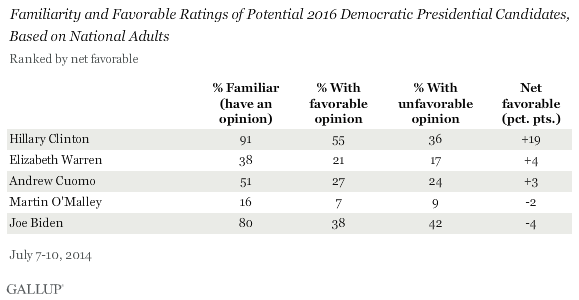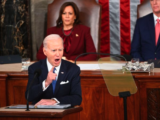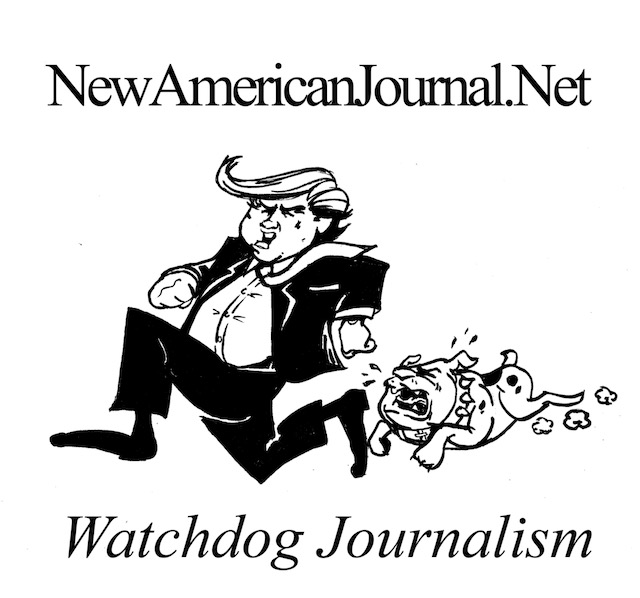Hillary Clinton is currently the best known and best liked of 16 potential 2016 presidential candidates, according to the latest Gallup poll on the subject, due to her 91 percent familiarity score and plus 19 net favorable rating. The net favorable is based on her 55 percent favorable and 36 percent unfavorable ratings.
In the graph seen above, those potential candidates in the upper-right quadrant are viewed more positively than negatively by Americans and have above average familiarity. The further candidates in that quadrant are away from the intersecting lines, the higher their scores are on both dimensions.
“The graph clearly shows Clinton’s strong image positioning relative to other candidates at the moment for the general election,” Gallup says.
Those potential candidates in the other three quadrants have weaknesses in familiarity, favorability, or both. Those in the lower-right quadrant are better known but less well liked, and must work to change people’s opinions about them. Those in the upper-left quadrant are better liked but less well known, and their challenge lies more in becoming nationally known figures.
Huckabee May Have Slight Edge in GOP Field for General Election
Former Arkansas governor and current talk show host Mike Huckabee is arguably in a slightly better position image-wise among the national adult population than other potential Republican presidential candidates, according to Gallup.
His +12 net favorable rating edges out Kentucky Sen. Rand Paul’s +9 for the highest among Republican candidates. Huckabee’s 54 percent familiarity score trails those for New Jersey Gov. Chris Christie (65 percent) and former Florida Gov. Jeb Bush (65 percent), but is above the 52 percent average for the 11 Republicans measured in the poll. Christie’s and Bush’s net favorable ratings are among the lowest.
Florida Sen. Marco Rubio has an above average +8 net favorable among national adults, but lags other Republican candidates with 46 percent familiarity. Texas Gov. Rick Perry and Wisconsin Rep. Paul Ryan are slightly above average in terms of both of favorability and familiarity.
Louisiana Gov. Bobby Jindal has the same +6 net favorability as Perry and Ryan, but is among the least well-known Republicans included in the poll with 38 percent familiarity. Texas Sen. Ted Cruz, Wisconsin Gov. Scott Walker, and former Pennsylvania Sen. Rick Santorum are below average in both favorability and familiarity, with Santorum viewed more negatively than positively.
Biden Is Well-Known, Not Well-Liked
Two of the five Democrats included in the poll have net negative favorable ratings — Vice President Joe Biden and Maryland Gov. Martin O’Malley. O’Malley is the least known potential candidate in the survey, with 83 percent of Americans not having an opinion of him.
“Biden’s net negative favorable rating could be more troubling in terms of his 2016 prospects, as 80 percent of Americans have an opinion of him, second only to Clinton among the 16 candidates in the poll,” Gallup says.
Americans are slightly more likely to have a positive than negative view of Massachusetts Sen. Elizabeth Warren (21 percent favorable, 17 percent unfavorable) and New York Gov. Andrew Cuomo (27 percent favorable, 24 percent unfavorable).
“Cuomo is the better known of those two, but still has below average familiarity,” Gallup says.
Perry, Christie, Cruz Images Recovering?
The candidates with net negative favorable ratings can take some solace in knowing that Americans are quick to forgive — or perhaps to forget — when politicians do things that reflect negatively on them.
Three of the potential candidates in the current survey — Perry, Christie and Cruz — were rated much more negatively than positively the last time Gallup asked about them, and all are back to at least a slightly more positive than negative favorable rating.
“Perry’s recovery may be the most impressive,” Gallup says.
When Gallup last measured him in December 2011, with his 2012 presidential campaign sputtering due to poor debate performances, he had a net favorable rating of -28 (27 percent favorable, 55 percent unfavorable). His familiarity scores are down since then, from 82 percent to 58 percent, but those able to rate him are now more positive than negative.
Christie became a prominent and well-regarded national figure known for taking on the Democratic legislature in New Jersey and for his response to Superstorm Sandy. In June 2013 he had a +32 net favorable rating. The “Bridgegate” scandal last fall sent Christie’s image plummeting, to a net -9 favorable rating earlier this year, before improving to +1 in the current poll.
Cruz, a central figure in the government shutdown last fall, had a net favorable rating of -10 in an October 2013 Gallup poll. Eight months later, his net favorable rating is back to +2.
“Biden is the only potential candidate whose image is notably worse than the last time Gallup measured him, with his net favorable rating slipping to -4 from +4 in February,” Gallup says.
Implications
“The viability of a candidate’s chances depends both on voters knowing who the candidate is, but also on voters having a positive impression of the candidate. Candidates usually become better known over the course of a campaign, but those who are better known at the outset have an advantage in that they don’t have to work as hard to attract attention to, or raise money for, their campaigns,” Gallup says in its analysis. “On the other hand, those who are well-known may have more difficulty improving their image during a campaign.”
“Although Clinton is the best-liked potential candidate in the poll — 18 months before the first primaries or caucuses — her favorable ratings are lower now than when she was secretary of state,” Gallup says.
They are, however, better than in July 2006, a year-and-a-half before the 2008 primaries, when she had a +6 net favorable rating (50 percent favorable, 44 percent unfavorable), before running a competitive but ultimately unsuccessful bid for the Democratic presidential nomination.
“So while Clinton’s image has lost some of its luster as she has moved from a less overtly political role as secretary of state to her current role as a book author and potential presidential candidate,” Gallup concludes, “she is in an arguably stronger position with the public now than she was before her 2008 presidential campaign.”
Survey Methods
Results for this Gallup poll are based on telephone interviews conducted July 7-10, 2014, with a random sample of 1,013 adults, aged 18 and older, living in all 50 U.S. states and the District of Columbia. For results based on the total sample of national adults, the margin of sampling error is plus or minus 4 percentage points at the 95 percent confidence level.
Before you continue, I’d like to ask if you could support our independent journalism as we head into one of the most critical news periods of our time in 2024.
The New American Journal is deeply dedicated to uncovering the escalating threats to our democracy and holding those in power accountable. With a turbulent presidential race and the possibility of an even more extreme Trump presidency on the horizon, the need for independent, credible journalism that emphasizes the importance of the upcoming election for our nation and planet has never been greater.
However, a small group of billionaire owners control a significant portion of the information that reaches the public. We are different. We don’t have a billionaire owner or shareholders. Our journalism is created to serve the public interest, not to generate profit. Unlike much of the U.S. media, which often falls into the trap of false equivalence in the name of neutrality, we strive to highlight the lies of powerful individuals and institutions, showing how misinformation and demagoguery can harm democracy.
Our journalists provide context, investigate, and bring to light the critical stories of our time, from election integrity threats to the worsening climate crisis and complex international conflicts. As a news organization with a strong voice, we offer a unique, outsider perspective that is often missing in American media.
Thanks to our unique reader-supported model, you can access the New American journal without encountering a paywall. This is possible because of readers like you. Your support keeps us independent, free from external influences, and accessible to everyone, regardless of their ability to pay for news.
Please help if you can.
American journalists need your help more than ever as forces amass against the free press and democracy itself. We must not let the crypto-fascists and the AI bots take over.
See the latest GoFundMe campaign here or click on this image.
Don't forget to listen to the new song and video.
Just because we are not featured on cable TV news talk shows, or TikTok videos, does not mean we are not getting out there in search engines and social media sites. We consistently get over a million hits a month.
Click to Advertise Here


